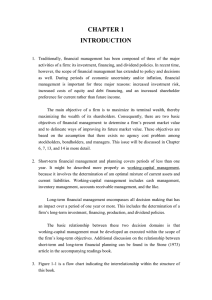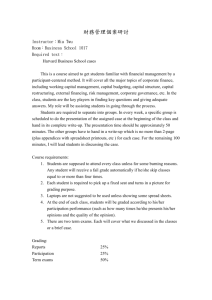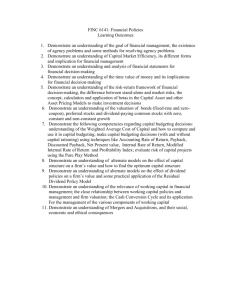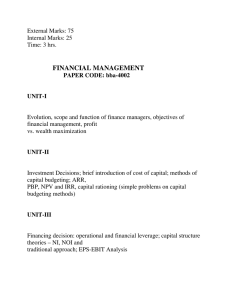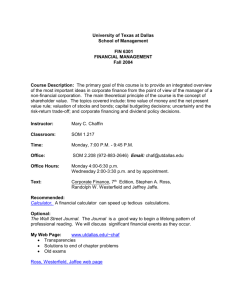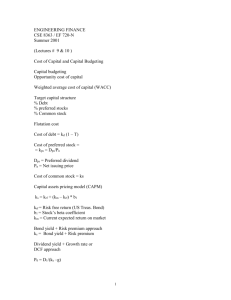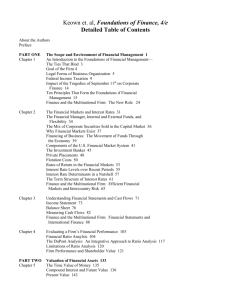Major Changes
advertisement
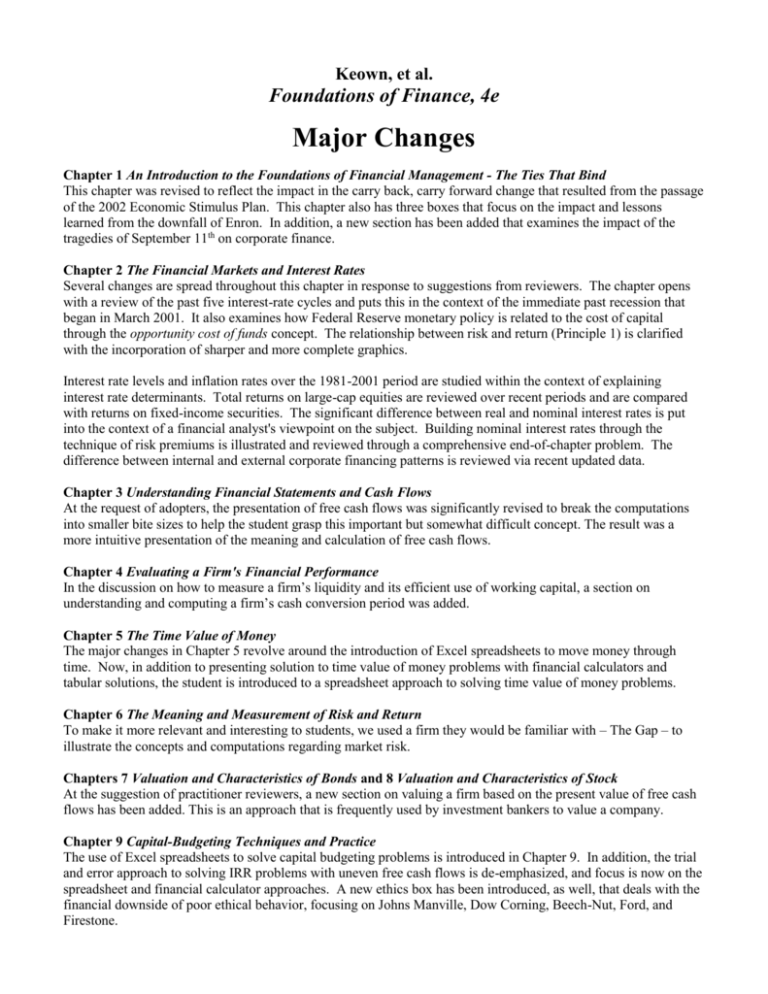
Keown, et al. Foundations of Finance, 4e Major Changes Chapter 1 An Introduction to the Foundations of Financial Management - The Ties That Bind This chapter was revised to reflect the impact in the carry back, carry forward change that resulted from the passage of the 2002 Economic Stimulus Plan. This chapter also has three boxes that focus on the impact and lessons learned from the downfall of Enron. In addition, a new section has been added that examines the impact of the tragedies of September 11th on corporate finance. Chapter 2 The Financial Markets and Interest Rates Several changes are spread throughout this chapter in response to suggestions from reviewers. The chapter opens with a review of the past five interest-rate cycles and puts this in the context of the immediate past recession that began in March 2001. It also examines how Federal Reserve monetary policy is related to the cost of capital through the opportunity cost of funds concept. The relationship between risk and return (Principle 1) is clarified with the incorporation of sharper and more complete graphics. Interest rate levels and inflation rates over the 1981-2001 period are studied within the context of explaining interest rate determinants. Total returns on large-cap equities are reviewed over recent periods and are compared with returns on fixed-income securities. The significant difference between real and nominal interest rates is put into the context of a financial analyst's viewpoint on the subject. Building nominal interest rates through the technique of risk premiums is illustrated and reviewed through a comprehensive end-of-chapter problem. The difference between internal and external corporate financing patterns is reviewed via recent updated data. Chapter 3 Understanding Financial Statements and Cash Flows At the request of adopters, the presentation of free cash flows was significantly revised to break the computations into smaller bite sizes to help the student grasp this important but somewhat difficult concept. The result was a more intuitive presentation of the meaning and calculation of free cash flows. Chapter 4 Evaluating a Firm's Financial Performance In the discussion on how to measure a firm’s liquidity and its efficient use of working capital, a section on understanding and computing a firm’s cash conversion period was added. Chapter 5 The Time Value of Money The major changes in Chapter 5 revolve around the introduction of Excel spreadsheets to move money through time. Now, in addition to presenting solution to time value of money problems with financial calculators and tabular solutions, the student is introduced to a spreadsheet approach to solving time value of money problems. Chapter 6 The Meaning and Measurement of Risk and Return To make it more relevant and interesting to students, we used a firm they would be familiar with – The Gap – to illustrate the concepts and computations regarding market risk. Chapters 7 Valuation and Characteristics of Bonds and 8 Valuation and Characteristics of Stock At the suggestion of practitioner reviewers, a new section on valuing a firm based on the present value of free cash flows has been added. This is an approach that is frequently used by investment bankers to value a company. Chapter 9 Capital-Budgeting Techniques and Practice The use of Excel spreadsheets to solve capital budgeting problems is introduced in Chapter 9. In addition, the trial and error approach to solving IRR problems with uneven free cash flows is de-emphasized, and focus is now on the spreadsheet and financial calculator approaches. A new ethics box has been introduced, as well, that deals with the financial downside of poor ethical behavior, focusing on Johns Manville, Dow Corning, Beech-Nut, Ford, and Firestone. Chapter 10 Cash Flows and Other Topics in Capital Budgeting Chapter 10 underwent a major revision. At the request of adopters, the calculation of free cash flows now uses a more intuitive approach. The purpose of this change is to make it easier for both the student to understand and the professor to teach. In addition, a new section was added on options in capital budgeting. Chapter 11 The Cost of Capital The discussion of the cost of capital has been streamlined to increase student understanding and focus on the key issues that arise in evaluating a firm’s hurdle rate for new investments. We provide additional emphasis on the growing importance of the cost of capital as an element in the calculation of periodic firm performance measures like Economic Value Added. Chapter 12 Determining the Financing Mix At the request of reviewers the chapter has been streamlined in several places, but still retains the proper emphasis on the relationship between financial leverage use and capital structure design. A quick but complete overview of capital structure theory is included that does not stress the student and at the same time appeals to practicing managers. Real-world discussions have been added that involve the Coca-Cola Company, Harley-Davidson, Georgia-Pacific, and The Walt Disney Company. Chapter 13 Dividend Policy and Internal Financing This chapter adds more actual company examples and discussions. These include Starbucks Corporation, whose dividend choices are related to the "residual theory of dividend policy"; Coca-Cola Company; a new example that focuses upon Harley-Davidson's dividend policy; Ford Motor Company; and The Walt Disney Company. Several examples of stock repurchases are put forth. Chapter 14 Financial Forecasting, Planning, and Budgeting This is a new chapter placement for the materials covering financial forecasting, planning, and budgeting. It is now the first of three chapters that discuss working-capital management issues. Chapter 15 Introduction to Working-Capital Management The working-capital management chapter has been shortened and focuses on the risk-return tradeoff and the analysis of current liabilities. The discussion of the cash conversion cycle was moved up in the book to the chapter on financial statement analysis. Chapter 16 Liquid Asset Management The current asset management chapter has been shortened through the streamlining of the discussion of cash management. This change makes the chapter much more accessible for beginner students and provides them with an appreciation of the treasury function. Chapter 17 International Business Finance This chapter has been thoroughly revised to reflect changes in the international setting, including changes in the European Union resulting from the introduction of the Euro.
